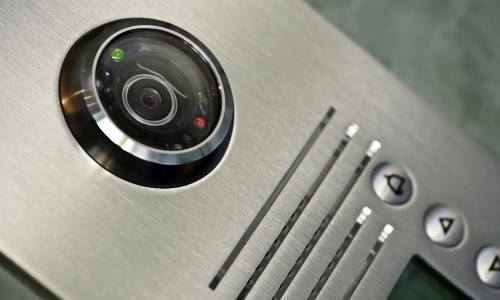6 Ways Intercoms Are Changing How Security Is Viewed
Here are six ways today’s intercoms are improving security and communications for users, and providing business prospects for security pros.

Intercoms are no longer just basic entry control and intra-office communication systems. Modern network-compatible video intercoms are tremendously versatile, either alone or integrated with other layers of security to provide end users with added performance, convenience and potential savings.
Here are six ways today’s intercoms are improving security and communications for users, and providing business prospects for security pros.
1. User Convenience: Access Control
Integrate a network-based video intercom with facial recognition software to create a hands-free solution for employee access control. You’ll see this more often as the cost of the biometric software continues to drop, making it a good choice for schools and small businesses.
The solution requires entering employee photos into the network database. The software compares faces captured by the intercom as employees approach the entry. If there’s a match, the intercom sends a signal to unlock the door without the need for cards, readers or office staff intervention. Organizations employing traditional access control can choose intercoms with embedded readers that enable card-carrying employees’ access to authorized areas.
2. Enhanced Security: Video
Improve entry security by integrating live video from an intercom door station and an additional security camera. A master station enables users to switch between video sources to get a good view of a visitor’s face, as well as a broader view of critical entries. This helps identify potential tailgaters and those attempting to smuggle weapons or other contraband into a facility. Cameras mounted on CCTV arms of emergency towers assist staff or first responders to formulate the best response to a call for help. Intercoms also integrate with video management systems (VMS) to record entry activity.
3. Reduce Costs: Communications
Intercom units communicate with one another via the network, potentially eliminating the need for staff at secured remote locations. Visitor calls can be forwarded to a security command center located a few to hundreds of miles away. Some network-compatible intercoms tie into a session initiation protocol (SIP) IP PBX server to forward calls to an external phone number such as a call center or first responder. SIP compatibility enables an intercom master station to replace VoIP phones while eliminating monthly phoneline fees and clearing desktop clutter. Intercoms are also ideal for multitasking. Guards on patrol can use a smartphone app to remain in control of the system.
4. RMR: Maintain Directories
Looking for recurring revenue? A video intercom at a main entry to a large commercial or residential multitenant building provides a good opportunity. Dealer and integrators can charge for remotely updating tenant directories via the facility network. It is also possible to update names and dialing numbers onsite using an NFC-equipped phone or tablet.
5. Quick Sales: Upgrade Legacy Units
Sharp-eyed dealers and integrators should be able to spot quick and easy retrofit prospects such as older legacy audio intercom stations. Many of these door units, in use for a decade or more, are connected to aging, oversized master stations lacking many modern features that improve performance and security. Also, audio door stations can be swapped out for video door stations by using analog to IP converter sets.
Making these intercoms part of a feature-rich, and more compact video intercom system isn’t difficult. There is rarely a need to pull new wire and network adaptors quickly turn one or dozens of these older intercoms into IP-addressable stations. Run them to a new master station offering LCD touchscreen control, customizable speed-dial buttons and more. From there, it’s a snap to make them part of a modern, networked video intercom system.
6. Versatility: Think Outside the Box
Intercoms meet the Americans with Disabilities Act (ADA) requirements for both audible and visual notification of a door opening. That takes place when the call is answered and the door lock is released. Many dealers and integrators help users go a step farther with custom messages such as instructions to a reception desk or an alternative after-hours entry.
Intercoms are also easy to install. It’s not unusual for integrators to partner with lock-smiths to install the low-voltage devices along with new door locks.
But here’s a quick tip: Don’t think about installing a network-compatible intercom system without first involving the customer’s IT department. In the case when projects don’t go as planned, more often than not there was no early input from the people in charge of the network.
Paul Hefty is a technical sales and support engineer II for Redmond, Wash.-based Aiphone Corp.
If you enjoyed this article and want to receive more valuable industry content like this, click here to sign up for our FREE digital newsletters!

Security Is Our Business, Too
For professionals who recommend, buy and install all types of electronic security equipment, a free subscription to Commercial Integrator + Security Sales & Integration is like having a consultant on call. You’ll find an ideal balance of technology and business coverage, with installation tips and techniques for products and updates on how to add to your bottom line.
A FREE subscription to the top resource for security and integration industry will prove to be invaluable.













